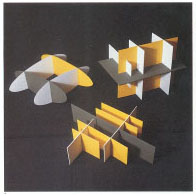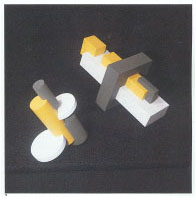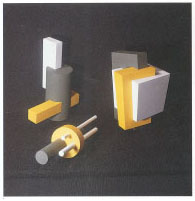| the
first law: the things that
can be unified on the basis of constructive principles may be both material
and non-material, but they are always
subject to the recording action of our brain by means of sight, hearing
and touch. |
the
sixth law:
every new construction is the result of a human being's investigations,
and of his requirement to be inventive and creative. |
| the
second law: every construction
is a construction only when thr unification of those elements in that way
can be rationally justified. |
the
seventh law:
everything that is really constructive is beautiful. everything that is
beautiful is completely perfected. everything that is completely perfected
is a contribution to the the culture of the future. |
| the
third law: a fully constructive
combination is obtained when elements are grouped together in a way that
creates harmonic relationships between them. |
the
eighth law:
in every constructive amalgamation lies the idea of humanity's collectivism.
in the close cohesion of the diverse elements is reflected the concord of
all man's finest aspirations. |
| the
fourth law:
elements amalgamated into a new entity form a construction when they penetrate
or embrace each other, are coupled or bedded together, i.e. when they demonstrate
their active participation in the movement of union. |
the
ninth law:
every constructive solution must have a motive on the basis of which the
construction is made. |
| the
fifth law:
every constructive amalgamation consists of the sum total of those trusts
and movements which in varying degree contribute to the integral quality
of the impression conveyed by the whole. |
the
tenth law: in order to create a constructive image it is necessary
to have absolute knowledge not only of the fundamentals of constructivism,
but equally of the processes by which that image will be reproduced in reality. |
| the
eleventh law:
before taking form, either as representation or reality, a constructive
object must go through all the stages of building up and development that
are necessary and possible. |
| Legitimacy
in all constructive structures depends upon being able simultaneously to
prove the truth and the correctness of thechosen solution by analytical
means. The form we have devised is legitimate to the extent that it is justifiable. |
| In
all design we face the necessity of giving foundations to, and thereby as
it were legitimising, the construction that we have finally adopted. we
must prove that the construction which we are proposing is correct and fits
the case concerned. |







